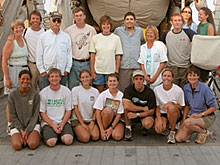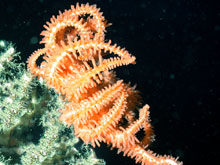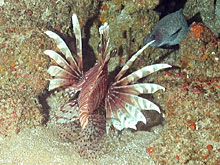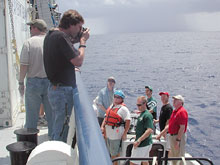
The Life on the Edge expedition team on the stern of the R/V Seward Johnson near the end of the August 2003 voyage. Click image for larger view.
2003 Life on the Edge Mission Summary
The overarching goal of the 2003 "Life on the Edge: Exploring Deep Ocean Habitats" mission was to explore and ultimately compare and contrast the closely associated ecosystems of the outer shelf hard grounds and midslope deep coral (Lophelia) banks off the Carolinas. A diverse and disciplined team of scientists and educators representing several state and federal agencies, one public museum, two universities, and one multimedia production company joined forces to achieve this goal.
Deep study areas such as these off the Carolinas, between 100 and 1,000 m, are important frontiers, offering a transition from the continental shelf to the true deep sea. These areas are often poorly studied relative to the continental shelves of the United States and the Gulf of Mexico, and, in many cases, they are completely unknown. Because the bottom topography is extremely rugged and/or the habitats are overlain by extreme currents, nonconventional sampling methods were incorporated into the mission’s research design.
In addition to surface and midwater sampling with a variety of equipment, including Tucker trawls, plankton net trawls, neuston netting, otter trawling, nightlighting, rod and reel, and dip netting, we deployed a remotely operated vehicle (ROV) and made daily dives with the Johnson-Sea-Link II manned submersible. All of these at-sea activities will be followed up by extensive data compilation and analysis in the laboratories of the various scientists who participated in the mission (see the August 26 Daily Log for more details). It is anticipated that several scientific manuscripts, oral presentations at scientific meetings and workshops, and graduate theses will be augmented or completed based on the results of this expedition.

This photo of a bright orange brittle star was taken from inside the submersible. Click image for larger view.
Overall, the submersible and surface investigations were undertaken at four primary target sites along the outer shelf and slope of the Carolinas. Undersea operations comprised 17 submersible dives plus one ROV dive. Approximately 600 digital still images from underwater in-situ photography were obtained to document the fish and invertebrate fauna as well as reef habitats. Digital images documenting more than 40 species were also obtained from sampled specimens prepared in the laboratory.
Deployment of the unmanned ROV video platform confirmed for the first time that the sea-floor target known as the “Snowy Wreck” is indeed a shipwreck of a steel-hulled, 120-ft-long vessel that is largely intact (see the August 18 Daily Log for more details). Sampling operations conducted from the surface comprised 50 surface sampling stations, plus 21 midwater sampling stations using several of the gear types mentioned above. Tissue samples from 20 species (287 samples) were obtained for stable isotope analyses in relation to ongoing trophodynamic studies. (See the August 21 and August 24 Daily Logs for more details about the intentions behind these sampling operations and analyses.) A large number of fathometer surveys were also undertaken, with the resulting digital image files serving to pinpoint areas of undersea topography that document deep coral reefs.

After a year of trying, a lionfish specimen, such as the one pictured here, was collected during one of our JSL II dives. The lionfish, albeit exotic, is an uninvited transplant from the western Pacific. Click image for larger view.
Of particular note on this mission, a specimen of the exotic invasive species Pterois sp. -- the Indo-Pacific lionfish --was collected to document the existence of this invasive species in the Atlantic. Even more profound for some, and perhaps inspiring more questions than answers, may be the underwater submersible/video faunal observations taken before and after the arrival of a commercial fisheries boat at the MPA-2 site. This video documented what appeared to be a dramatic removal of large economic species during the time slot of the mission.
In addition to the science component of this expedition, education and outreach activities took place. Expedition updates were broadcast on the NOAA Ocean Explorer Web site with daily logs, images, and video clips from the Johnson-Sea-Link II. Eight lesson plans developed in accordance with the expedition’s goals and objectives were made available on this Web site. The North Carolina Museum of Natural Sciences' Web site ![]() hosted the “Life on the Edge” virtual trek
hosted the “Life on the Edge” virtual trek ![]() . This included daily journal entries, curriculum materials, GIS (geographic information system) maps, and images from the cruise. Additionally, more than 50 questions from across North Carolina and the United States were posed, facilitated via the U.S. Geological Survey, and answered on the site.
. This included daily journal entries, curriculum materials, GIS (geographic information system) maps, and images from the cruise. Additionally, more than 50 questions from across North Carolina and the United States were posed, facilitated via the U.S. Geological Survey, and answered on the site.
A media day was held on August 20 with representatives from magazines, newspapers, television, NOAA, and North Carolina Sea Grant ![]() in attendance. The guests watched a sub launch and recovery, toured the ship, visited the ROV locker, and talked with the science party.
in attendance. The guests watched a sub launch and recovery, toured the ship, visited the ROV locker, and talked with the science party.
Art Howard of NAPRO Communications also joined the mission on August 20 to continue work on a high-definition (HD) movie for the North Carolina Museum of Natural Sciences begun during NOAA's 2002 "Islands in the Stream" expedition last summer. He filmed during several submersible dives and interviewed members of the science team. He also shot footage of some of the ship activities, such as nightlighting, surveying, and working up specimens. Additionally, he took many still shots for use in the museum's biannual magazine North Carolina Naturalist. (See the August 22 Daily Log for more details.)
All told, this expedition to study and compare life on the shelf edge off the Carolinas was extremely productive, and, ideally, the various outcomes of this cruise will broaden the minds of practiced scientists and novices alike.






















